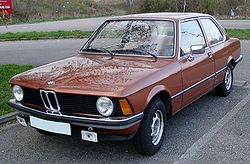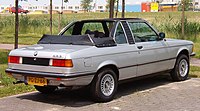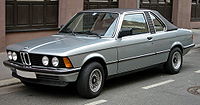BMW E21
| BMW | |
|---|---|
|
BMW 316 (1975-1979)
|
|
| E21 | |
| Sales designation: | 3 series |
| Production period: | 1975-1983 |
| Class : | Middle class |
| Body versions : | limousine |
| Engines: |
Petrol engines : 1.6–2.3 liters (55–105 kW) |
| Length: | 4355 mm |
| Width: | 1610 mm |
| Height: | 1380 mm |
| Wheelbase : | 2565 mm |
| Empty weight : | 1010-1180 kg |
| Previous model | BMW 02 |
| successor | BMW E30 |
With the factory code BMW E21 vehicles are the first 3 Series from BMW called that in August 1975 as a successor to the 02 models came on the market. The E21, only available with two doors, was available with a four-cylinder ( M10 ) and from summer 1977 also with a six-cylinder in - line engine ( M20 ) and was built until December 1983.
In December 1982, the successor E30 appeared , which was also offered with four doors, as a station wagon (touring), full convertible and with a diesel engine .
A total of 1,364,039 vehicles of all engine types were built, 4595 of which were converted into Baur top convertibles , which were offered with all engines via the BMW dealer organization between 1977 and 1982.
Model history
General
The design of the E21 comes from Paul Bracq , who had already drawn the first 5 Series BMW E12 . The first models of the E21 were delivered without the black plastic cover between the rear lights. Customer protests because of the barren rear (the license plate was still mounted between the lights on the predecessor) prompted BMW to introduce a corrugated rear panel into series production four months after the start of production in August 1975.
The vehicles with the "small" four-cylinder engines (315, 316, 318 and 318i) also differ externally from the 320, 320i and 323i variants. They have individual round headlights of 7 "(approx. 178 mm) diameter, which, depending on the model version and year of manufacture, are partly equipped with R2 twin-filament lamps or H4 halogen lamps . The models from BMW 320 are equipped with two 5 3/4" (approx. 146 mm) mm) large round headlights, the six-cylinder models can be recognized by the nameplate in the radiator grille. The BMW 323i with the K-Jetronic - manifold injection is the only option two tailpipes left and right at the rear. The "i" behind the number combination stands for "injection", ie intake manifold injection - models without an "i" have carburettors .
In September 1978 the black surface under the chrome nameplate was removed. The front seats that had been taken over from the BMW 02 were replaced by new designs in which, among other things, the belt buckles are attached to the seat frame. The exhaust on models 316 to 320 has been moved further away from the license plate in place of the left 323i exhaust.
Maserati based the Biturbo model, which appeared in 1981, on the concept of the 3-series BMW.
Facelift
As part of a facelift in August 1979 (model year 1980), all BMW 3 Series received rear lights split up again with - depending on the scope of equipment - integrated rear fog lights. Instead of the chrome-plated exterior mirrors, there were now exterior mirrors made of black plastic (except for 315 electrically adjustable) that were no longer mounted on the door panel, but in the so-called mirror triangle.
The front apron was modified and equipped with a larger spoiler, the radiator was relocated to the front of the front mask, so that a V-belt-driven fan (previously electrically driven) could be found in the 6-cylinder models. The exhaust system has also been revised.
In the interior, the models had a redesigned center console with a centrally arranged, round hazard warning switch and modified heating controls. The gear lever knob was given a plexiglass circuit diagram.
Up to and including model year 1980, there was only one interior variant of the BMW E21. From model year 1981 onwards, the various engines differ in various interior details: from model year 1981 onwards, the six-cylinder models were given higher quality upholstery fabrics and more elaborate door panels with fabric inserts, while the equipment on the 315 was reduced. All models from BMW 320 onwards have a rev counter as standard.
Various savings measures were implemented in the basic version 315, which was newly introduced in April 1980 and which was offered in parallel to the successor E30 until mid-1984. Among other things, the 315 only has a mechanically adjustable exterior mirror as standard, a parcel shelf covered with artificial leather (all other models here had carpet), no map pockets on the side of the door panels, bumpers with visible connecting screws and instead of H1 / H4 halogen headlights those with R2 two-thread -Bulbs .
The most conspicuous external distinguishing feature of the 315 was the frame of the side windows, which were painted matt black, the panels made of polished aluminum were omitted (exception: special equipment rear vent window, in this case the side window frames were designed as on the 316 to 323i). The only chrome trim on the side were the window slot strips, the rain gutters and the chrome insert in the bumper strips. The 315 cost 15,850 DM ex works in 1981 (according to today's purchasing power 16,400 euros).
For some export markets, the 315 was temporarily equipped with the 318i engine and delivered under the name "318i Bavaria".
Technical specifications
| model | engine | Displacement | design type | Max. power | Mixture preparation | Acceleration 0-100 km / h | Vmax. | Consumption l / 100km | construction time |
|---|---|---|---|---|---|---|---|---|---|
| BMW 315 | BMW M10 | 1.6l | R4 | 55 kW / 75 PS | Carburetor Pierburg 1B2 | 14.8 s | 154 km / h | 8.8 super plus (98 octane) | 03.1981-12.1983 |
| BMW 316 | BMW M10 | 1.6l | R4 | 66 kW / 90 PS | Solex 32/32 DIDTA register carburetor | 13.8 s | 160 km / h | 9.5 normal (91 octane, E10 approved) | 08.1975-08.1980 |
| BMW 316 | BMW M10 | 1.8l | R4 | 66 kW / 90 PS | Register carburetor Pierburg 2B4 | 12.5 s | 163 km / h | 9.0 super plus (98 octane) | 09.1980-08.1982 |
| BMW 318 | BMW M10 | 1.8l | R4 | 72 kW / 98 PS | Solex 32/32 DIDTA register carburetor | 11.9 s | 165 km / h | 9.6 normal (91 octane, E10 approved) | 08.1975-08.1980 |
| BMW 318i | BMW M10 | 1.8l | R4 | 77 kW / 105 PS | Bosch K-Jetronic intake manifold injection | 11.5 s | 179 km / h | 8.9 super plus (98 octane) | 11.1979-08.1982 |
| BMW 320 (320/4) | BMW M10 | 2.0l | R4 | 80 kW / 109 PS | Solex 32/32 DIDTA register carburetor | 11.2 s | 170 km / h | 10.0 normal (91 octane, E10 approved) | 08.1975-08.1977 |
| BMW 320 (320/6) | BMW M20 | 2.0l | R6 | 90 kW / 122 PS | Double register carburetor Solex 4A1 | 10.7 s | 181 km / h | 9.9 super plus (98 octane) | 09.1977-08.1982 |
| BMW 320i | BMW M10 | 2.0l | R4 | 92 kW / 125 PS | Bosch K-Jetronic intake manifold injection | 9.9 s | 183 km / h | 9.4 super plus (98 octane) | 08.1975-08.1982 |
| BMW 323i | BMW M20 | 2.3l | R6 | 105 kW / 143 PS | Bosch K-Jetronic intake manifold injection | 9.5 s | 190 km / h | 9.6 super plus (98 octane) | 01.1978-08.1982 |
Consumption data apply to the Germany version and were collected in a DIN third mix (320/4 and 320i: DIN 70030) with a standard gearbox.
Other model variants
There was a separate version of the 320i for the US market, which changed in September 1979. It was only available in this way in the USA.
- 320i: 2.0 l with 81 kW / 110 PS; M10 four-cylinder with manifold injection K-Jetronic (US version up to 1979)
- 320i / 320is: 1.8 l with 74 kW / 101 hp; M10 four-cylinder with K-Jetronic intake manifold injection and controlled catalytic converter (US version from 09.1979)
In addition, the E21 was the basis for various tuning companies such as Alpina or AC Schnitzer . Alpina first used the tuning kits known from the BMW 02 for the M10 engine (A0 - A4) before Alpina brought the first vehicle onto the market with the B6 (E21 with BMW M30 engine, 2.8 liters, 218 HP (first series only 200 HP)). There was also the Alpina C1, which is based on the small six-cylinder (M20 engine, 2.3 liters, 170 hp).
Towards the end of the E21 construction period, there were still two special models - the Edition E and Edition S variants . Edition E was available for the 318i, 320 and 323i engines, Edition S for the 323i. Edition E, which was designed for comfort, was given more elegant velor fabrics from the 7 series and headrests in the rear, as well as light alloy wheels, exterior mirrors painted in the vehicle color and a sports steering wheel. Available paintwork was opal green metallic. The sportier Edition S featured front and rear spoilers from BBS, as well as BBS cross-spoke wheels made of light alloy, Recaro sports seats, a five-speed gearbox and a sports steering wheel. Available paint finishes were graphite gray and ascot gray, and in some foreign markets also two-tone graphite gray / ascot gray.
Prices
Base price of the models available in August 1975
- 316 - 13,600 DM (today corresponds to inflation-adjusted € 18,200)
- 318 - 14,420 DM (corresponds today to inflation-adjusted € 19,300)
- 320 - 15,330 DM (today corresponds to € 20,500 adjusted for inflation)
- 320i - 17,400 DM (today corresponds to € 23,300 adjusted for inflation)
literature
- Walter Drawer: Type compass BMW, passenger car since 1952 . 1st edition, Motorbuch Verlag, Stuttgart 1998, ISBN 3-613-01873-X
Web links
Individual evidence
- ↑ TC1-Individual - Numbers - Facts - Delivery. In baur-tc1.de
| Timeline of the glass series models from 1955 to 1969 | |||||||||||||||||||||
|---|---|---|---|---|---|---|---|---|---|---|---|---|---|---|---|---|---|---|---|---|---|
| Type | independent (Hans Glas GmbH) | BMW | |||||||||||||||||||
| 1950s | 1960s | 1970s | |||||||||||||||||||
| 5 | 6th | 7th | 8th | 9 | 0 | 1 | 2 | 3 | 4th | 5 | 6th | 7th | 8th | 9 | 0 | 1 | 2 | 3 | 4th | ||
| Microcar | Goggomobil T | ||||||||||||||||||||
| Small car | Isar ("large Goggomobil") | ||||||||||||||||||||
| Lower middle class | 1004, 1204, 1304 | ||||||||||||||||||||
| Middle class | 1700 | 1800 SA, 2000 SA / 1804, 2004 [1] | |||||||||||||||||||
| Coupe | Goggomobil TS | ||||||||||||||||||||
| 1300 GT, 1700 GT | 1600 GT [2] | ||||||||||||||||||||
| 2600 V8, 3000 V8 | 3000 V8 [3] | ||||||||||||||||||||
| Vans | Goggomobil TL | ||||||||||||||||||||
|
|
|||||||||||||||||||||















